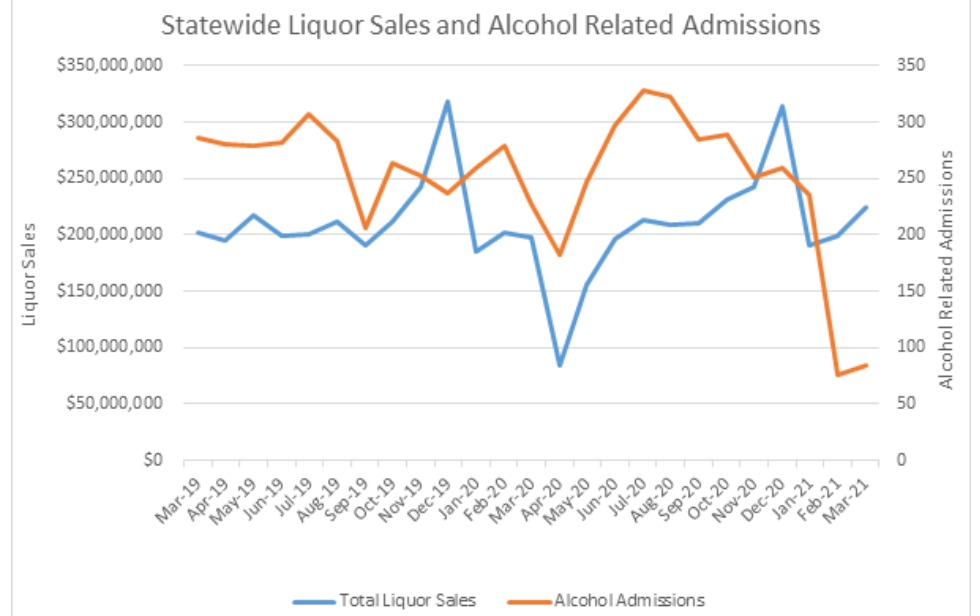Back
Poster Session E - Tuesday Afternoon
E0475 - Trends in Retail Alcohol Sales and Alcohol-Related Admissions at a Tertiary Medical Center in Pennsylvania During the COVID-19 Pandemic
Tuesday, October 25, 2022
3:00 PM – 5:00 PM ET
Location: Crown Ballroom

Deepa Kumarjiguda, DO
Geisinger Health System
Danville, PA
Presenting Author(s)
Deepa Kumarjiguda, DO1, Harrison R. Malcolm, JD, DO1, Benyam Addissie, MD1, Andrea Berger, MA2
1Geisinger Health System, Danville, PA; 2Geisinger Center for Health and Research, Danville, PA
Introduction: Alcohol sales increased nationwide during the pandemic but this trend was reversed in Pennsylvania as state owned liquor stores closed for three months at the beginning of the pandemic. The effect of this change on hospital admissions for alcohol related diagnoses during the height of the pandemic is unknown. Our study aims to characterize the relation between alcohol sales during the early pandemic and the rates of alcohol related admissions compared to the year prior in a rural Pennsylvania area within a tertiary health system.
Methods: This is a retrospective chart review of the Geisinger network hospital admissions for alcohol-related diagnoses using CDC ARDI Alcohol-related ICD-10 codes between March 1, 2019 to February 29, 2020 (Period 1) and March 1, 2020 to March 31, 2021 (Period 2) compared with county-level sales data from the Pennsylvania Liquor Control Board and the Pennsylvania Department of Revenue. The relationship between monthly alcohol related admissions and monthly liquor sales was tested with linear regression models. Differences between male and female mortality between period 1 and period 2 were compared using generalized estimating equations. We also compared in-hospital, 30, 90, and 180 day all -cause mortality between the two periods.
Results: We identified 6297 admissions of 4335 unique patients in the study period. There was no statistically significant association between monthly alcohol- related admissions and alcohol sales (p = 0.2758) in the selected study period (Figure 1). Male mortality during the admission (1.8% vs 1.0%, p = 0.0299) and at 30 day post discharge (3.0% vs 2.4%, p = 0.0306) were greater in the second period compared to the first. Fewer women died in the second period from March 2020 to March 2021 compared to March 2019 to February 2020 (7.1% vs 10.7%, p = 0.0002).
Discussion: The lack of a significant relationship between alcohol sales and related admissions may be related to fluctuations in the incidence of individual alcohol-related diagnoses or the limitations of using sales as a proxy for consumption. The difference in male vs female mortality between the two periods may be related to higher male mortality from COVID-19 which has been observed worldwide. Further studies are required to assess the impact of COVID-19 on alcohol-specific GI and liver diseases. Although measures restricting alcohol sales have been used to lower the health impact of alcohol, such measures may not be as effective in a setting of COVID-19 pandemic.

Disclosures:
Deepa Kumarjiguda, DO1, Harrison R. Malcolm, JD, DO1, Benyam Addissie, MD1, Andrea Berger, MA2. E0475 - Trends in Retail Alcohol Sales and Alcohol-Related Admissions at a Tertiary Medical Center in Pennsylvania During the COVID-19 Pandemic, ACG 2022 Annual Scientific Meeting Abstracts. Charlotte, NC: American College of Gastroenterology.
1Geisinger Health System, Danville, PA; 2Geisinger Center for Health and Research, Danville, PA
Introduction: Alcohol sales increased nationwide during the pandemic but this trend was reversed in Pennsylvania as state owned liquor stores closed for three months at the beginning of the pandemic. The effect of this change on hospital admissions for alcohol related diagnoses during the height of the pandemic is unknown. Our study aims to characterize the relation between alcohol sales during the early pandemic and the rates of alcohol related admissions compared to the year prior in a rural Pennsylvania area within a tertiary health system.
Methods: This is a retrospective chart review of the Geisinger network hospital admissions for alcohol-related diagnoses using CDC ARDI Alcohol-related ICD-10 codes between March 1, 2019 to February 29, 2020 (Period 1) and March 1, 2020 to March 31, 2021 (Period 2) compared with county-level sales data from the Pennsylvania Liquor Control Board and the Pennsylvania Department of Revenue. The relationship between monthly alcohol related admissions and monthly liquor sales was tested with linear regression models. Differences between male and female mortality between period 1 and period 2 were compared using generalized estimating equations. We also compared in-hospital, 30, 90, and 180 day all -cause mortality between the two periods.
Results: We identified 6297 admissions of 4335 unique patients in the study period. There was no statistically significant association between monthly alcohol- related admissions and alcohol sales (p = 0.2758) in the selected study period (Figure 1). Male mortality during the admission (1.8% vs 1.0%, p = 0.0299) and at 30 day post discharge (3.0% vs 2.4%, p = 0.0306) were greater in the second period compared to the first. Fewer women died in the second period from March 2020 to March 2021 compared to March 2019 to February 2020 (7.1% vs 10.7%, p = 0.0002).
Discussion: The lack of a significant relationship between alcohol sales and related admissions may be related to fluctuations in the incidence of individual alcohol-related diagnoses or the limitations of using sales as a proxy for consumption. The difference in male vs female mortality between the two periods may be related to higher male mortality from COVID-19 which has been observed worldwide. Further studies are required to assess the impact of COVID-19 on alcohol-specific GI and liver diseases. Although measures restricting alcohol sales have been used to lower the health impact of alcohol, such measures may not be as effective in a setting of COVID-19 pandemic.

Figure: Figure 1. There was no association between monthly alcohol related admissions and monthly alcohol sales (p = 0.2758) in the period from March 1, 2019 to January 31, 2021. The drastic drop occurring in admissions in April through March 2020 is likely due to the transition of instore sales to online sales and overall decreased admissions at the start of the COVID pandemic.
Disclosures:
Deepa Kumarjiguda indicated no relevant financial relationships.
Harrison Malcolm indicated no relevant financial relationships.
Benyam Addissie indicated no relevant financial relationships.
Andrea Berger indicated no relevant financial relationships.
Deepa Kumarjiguda, DO1, Harrison R. Malcolm, JD, DO1, Benyam Addissie, MD1, Andrea Berger, MA2. E0475 - Trends in Retail Alcohol Sales and Alcohol-Related Admissions at a Tertiary Medical Center in Pennsylvania During the COVID-19 Pandemic, ACG 2022 Annual Scientific Meeting Abstracts. Charlotte, NC: American College of Gastroenterology.
